
- Public Policy
- Leadership
- Funding
- News & Events
- About the Center
Back to Top Nav
Back to Top Nav
Back to Top Nav
Back to Top Nav
After beginning winter term with a session focused on the purpose of actively recruiting the next class of Rockefeller Leadership Fellows, this week the 2021 cohort of Fellows returned to routine with a session led by the Rockefeller Center’s own Professor Ron Shaiko. Shaiko discussed the topic of civil leadership with the Fellows and aided the Fellows in directly applying the topic to Dartmouth itself.
The first important concept introduced by Shaiko was civil society, which he defines as the social and political space between the citizen and the state. To elucidate, Shaiko named well-known collective action groups that operate in the space designated as civil society, such as Kiwanis Clubs, The Salvation Army, and Lions Club International. Unfortunately, organizations such as these are weakening as their members age and younger citizens elect not to participate in the groups. The struggles of collective action groups are best explained by social capital, which are features of social organization such as networks, norms, and social trust that facilitate coordination and cooperation for mutual benefit, a definition attributed by Shaiko to author Robert Putnam. Civil society organizations cultivate social capital for all members of a community, including individuals that are not members of those organizations. Those non-participators are referred to as free-riders, and, as Shaiko pointed out, are in fact making the most economically rational choice to reap the benefits of these collective action groups without participating themselves. Unfortunately, the rational choice being made by greater numbers of citizens is the source of the diminishment of these groups.
Shaiko explained two different types of social capital: bonding and bridging. The former type is marked by thick trust, while the latter is marked by thin trust. Bonding social capital is, as defined by Shaiko, the links between like-minded people, or the reinforcement of homogeneity. In contrast, bridging social capital is the building of connections between heterogeneous groups. To demonstrate the similarities and differences between these two types of social capital, Shaiko asked the Fellows to consider spaces where bonding and bridging social capital are cultivated on campus. In addition, the Fellows were tasked with envisioning opportunities where bridging social capital could be further developed. In particular, Shaiko mentioned the Dartmouth Housing System as an attempt by the college administration to foster more bridging social capital.
Leaders are often tasked with coalescing diverse identities into a cohesive, inclusive, and productive team. Understanding the different types of social capital that can be developed between people is critical to building successful teams. In addition, as Shaiko explicitly stated at the end of the session, the Fellows will likely go on to be leaders not only in their professional lives but in their personal lives in their communities as well. Community leaders can promote social cohesion by participating in collective action organizations that foster social capital and thereby benefit their communities.
-Written by Maria Smith-Lopez, Class of 2021 Rockefeller Leadership Fellow and Student Program Assistant
As Rockefeller Leadership Fellows, seniors gain a better understanding of the qualities and responsibilities expected of leaders. As Fellows take part in the workshops, discussions, and team-building exercises, they examine their skills, qualities, and attributes as leaders and analyze how these influence teamwork and achieving goals.